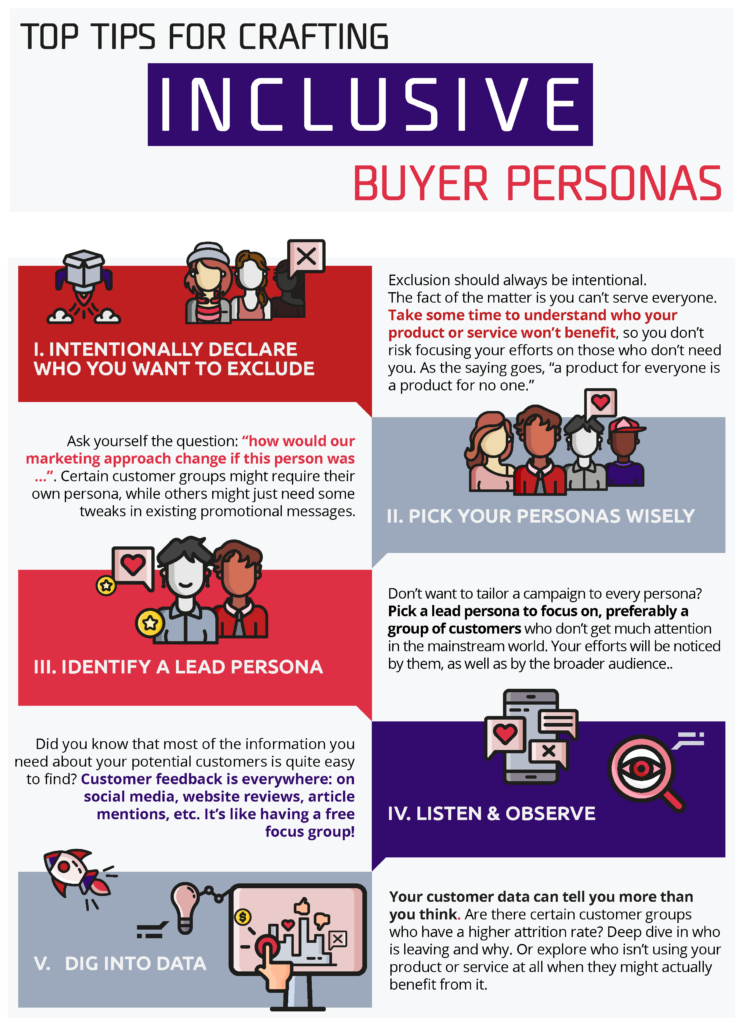The World Is Changing, so Should Your Buyer Personas
The tenets of Inbound Marketing require marketers to get up close and personal to their target audiences. Knowing your prospective customers’ likes, habits and challenges can inform you of how to best engage with them, where to reach them and when to share all of the valuable content you spend so much time creating.
Despite companies doing endless research to get to know their customers, the buyer personas they develop, more often than not, end up lifeless, limiting – and quite frankly – useless.
Traditional buyer personas often assign qualities and identities to fictional characters that have little to no bearing on the actual human being who is buying your product or service.

If you’re selling bolt cutters, does it matter whether Persona Peter has a Labrador or enjoys baseball?
Still, buyer personas are important. They inform copywriters of a preferred writing style, designers of imagery that will resonate and digital marketers of effective targeting settings.
So, then what’s the solution? A necessary approach to buyer personas is to make them inclusive, rather than exclusive. Not only does this align with Diversity, Equity and Inclusion principles, it will also help you reach more potential customers. And isn’t that ultimately what you want?
Cast Aside the Clichés
In the past few years, a lot of brands have started taking a different approach to marketing. Seeing same-sex or multiracial families in ads for soup, cars or insurance is no longer as groundbreaking as it once was (thank goodness!), even if negative comments remain prevalent.
But diversity and inclusion go well beyond simply inserting images of people of color.
An increasing amount of swimwear and undergarment brands are working with models of all shapes and sizes to demonstrate that their clothes are meant for all bodies. The past few Halloweens have seen little girls dressed as Rey from Star Wars and little boys in Black Panther costumes, proud to have heroes who look like them.
An image of a bridal shop window featuring a mannequin bride in a wheelchair struck a chord with many who marveled at the fact that disability is so rarely portrayed in situations where it isn’t presented as the focal point.
Media has an enormous influence on how people perceive themselves and each other.
As Alphonso David, president of the Human Rights Campaign, puts it:
“Representation matters because we all bring different perspectives to the table, and those perspectives are really informed by our experiences and our identities […]and who we are as people. They also inform how we look at the world. So, if those structures don’t incorporate our perspectives, then our perspectives don’t factor into decision-making. And if we don’t exist, then policies are developed and they ignore us to our own detriment.”
Buyer Personas: Ditching the Traditional Template
So, back to those pesky buyer personas. It’s not enough to simply replace one of your Caucasian male personas with a Black woman. Often, companies quickly check some inclusivity boxes as an afterthought without fully understanding the context behind the image. Inclusion must be authentic, not performative or stereotypical.
Most likely, your audience is not monolithic. Yet, as marketers, we tend to create ideal customer personas that are similar to ourselves, thereby unintentionally excluding potential customers with different experiences and backgrounds. It’s like a chef who doesn’t know anyone with dietary restrictions and doesn’t consider offering vegan or gluten-free options on the menu.
Getting to the core of your customers is about empathy and authenticity.
Take Nike, for example. The brand shattered the stereotypical image of buff and predominantly Western people in the sports industry by introducing a durable, lightweight hijab, enabling Muslim women to participate in sports by removing the practical barrier of wearing a religious item of clothing. Criticism was plenty, but sales among the Muslim community soared. Instead of zeroing in on their expected audience, they addressed the challenges of an unexpected consumer experience.
Are you willing to go beyond the token “diverse” character and work toward personas who can be their own authentic selves?
Reflect Your Global Audience
Once you start having honest conversations about the challenges different groups of people face as a result of their gender, race, ethnicity, sexual orientation, gender expression, abilities, etc., you can start building positive, non-stereotypical representations of diverse groups of people that keep into account their unique abilities and challenges, without limiting them to topics pertaining to their diverse identities.
If you’re planning on inviting more women to speak at your event, make sure they are invited to all panels relevant to their areas of expertise, not just the panels covering “Women in …”. Are you only inviting trans women to speak about transgender topics? Or do you take into account the full spectrum of their experience and expertise?
Why not make the inclusion of diverse characters and (multi-language) closed captions and voiceovers a standard for all videos, regardless of topic or target audience? You don’t need to wait for Pride Month to include LGBTQ+ people in your video. And while you’re at it, go ahead and add your pronouns to your email signature. Normalization is the road to inclusion.
Focus on Humanity
To truly engage with your audience, you’ll need to create content that resonates with potential customers’ everyday lives and experiences.
If you’re targeting women in their 30s and 40s who have full-time jobs on top of being caregivers of children and parents, you can’t waste their time with a 15-page white paper; you need to come up with something concise and easily digestible.
If your podcast series doesn’t come with full transcripts, you may miss neurodivergent audiences who struggle with auditory processing.
Ultimately, creating inclusive personas is about humanity. It’s about making an effort to really understand your potential customers and make them feel part of your story.
Whether you’re a multinational company wanting to enhance your internal communications with thousands of employees worldwide, or a medium-sized business wanting to expand your reach into new markets, you can’t just tick a couple of boxes and move on. Getting to know your customers deeply is a long-term, ongoing process.
When you put in the effort to make inclusion a priority, the content you create will be more engaging and valuable to the people you’re trying to reach.
Here are some tips to get started on your inclusive personas:

Looking for more marketing expertise?
Sign up for our newsletter
"(Required)" indicates required fields
YOU MAY ALSO LIKE…

How to add Video to your Digital Marketing Strategy
Digital marketing without video has become unthinkable. Now more than ever, marketers are using video to get their message across.
Read moreMake Your Message Heard with Authentic Communication
Our inboxes are stuffed. Social media platforms inundate us with advertisements practically every other minute. The world feels constantly abuzz. It’s really no stretch to say that communication channels today are oversaturated.
So, how can you make your communication stand out? And perhaps more importantly, when you have something meaningful to communicate, how do you ensure your intentions are clear in your messaging and people are really hearing you?
Authenticity is your answer.
The Trend of Authenticity
We know, we know, authenticity is everyone’s favorite buzzword lately. That’s not lost on us. But taking a second to reflect, authenticity’s rise to prominence makes a lot of sense. Culturally, we’re in the midst of a purpose pursuit. Having a sense of purpose motivates us to drive forward and achieve, and helps us feel fulfilled in life. Take millennials, for example, who’d rather pass up a higher salary to work for a company driven by social purpose.
In our pursuits of purpose, we are constantly yearning for a sense of authenticity; it’s important for us to quickly distinguish what’s real and what’s not. No more fake news – we want truth and transparency. It’s the physical embodiment of #NoFilter. We don’t have time to waste on facades of falsities – give it to us straight or don’t bother at all.
This insatiable desire for realness is also reflected in attitudes towards brands and businesses.

90% of consumers admit that authenticity is crucial when deciding which brands to support. We want the brands and businesses we support to also be driven by a sense of purpose, and we want to be able to easily distinguish what this purpose is through brand communications.
The rise of social media influencers could also be explained by our desires for authenticity. Who better to promote brands and businesses than everyday people living a seemingly normal life just like you?
With transparency and honesty in vogue, we’re seeing many major brands responding. Some are opting for influencers to authentically tell a meaningful story that exemplifies a brand’s purpose. Others are delivering campaigns fully centered on purpose, even if that means telling customers not to buy their product. All in all, it boils down to offering authentic realness in the place of perfectly curated execution.

Authenticity’s Shelf Life
Many speculate that it was Dove’s Real Beauty campaign launched in 2004 that initially gave authenticity within marketing its footing. Seventeen years later, authenticity is still relevant for brands and remains a powerful marketing and communication tool. It’s not lofty to assume that authenticity will continue on as the dominant trend shaping and maintaining how businesses market themselves and communicate to consumers.
If you haven’t yet introduced authenticity into your brand’s communications yet, now might be a good time to do so. However, it’s necessary to consider how exactly you will utilize authenticity, especially within your communications. This is something that should take critical thought and reflection because, while we can consider authenticity a trend in some ways, it’s also important to also recognize it as a philosophy. As such, we see authenticity’s salience, which hopefully discourages ill-intended businesses from capitalizing on authenticity to mislead consumers.
Don’t think about authenticity as a trend-wave to jump on. Recognize that implementing authenticity within your brand and communication should be a nuanced process. After all, there is no “one size fits all” method to creating authentic communication. Let’s dig a little deeper into authentic communication to understand this more.
What is Authentic Communication?
Most simply, for a business, authentic communication is messaging that transparently reflects the business’s values, motives and aspirations. Normally, authentic communication doesn’t stand alone. Rather, it’s backed up by the actions taken by a business to support what it believes in. And vice versa. Although, it should go without saying: if you say you’re going to do something, do it, otherwise don’t bother with authentic communication at all.

When it comes to tone, authentic communication doesn’t beat around the bush. It doesn’t hide or obscure truth (which, coincidentally, is what marketing and communication have historically been devised to do). It’s communication without hyperbole, fluff, or corporate buzz words.
It’s important to note that communicating authentically also has a lot to do with listening authentically. Creating truly authentic communication is a symbiotic process, requiring that you actively listen to the people your business engages with. Take responsibility for your communication and its impact. You should not only mean what you say but additionally, ask for feedback on what you say to ensure your messaging is resonating properly and genuinely.
One final principle of authentic communication is its ability to foster connection between the communicator and their audience. If done correctly, authentic communication should demonstrate a genuine interest and willingness to engage in dialogue with an audience in order to learn more from them and ultimately develop a lasting connection with them.

Authentic Communication to the Rescue?
So, if authenticity is the answer to amping up your communications to ensure they’re being heard and seen, shouldn’t you just cut the corporate lingo, put pen to paper and write directly from the heart?
Not so fast.
What’s interesting about authenticity and notably authentic communications, are the strict unspoken norms that govern what can actually be deemed authentic. Ironically enough, perfecting your authentic voice in order to produce genuinely authentic communication takes practice.
As we mentioned, there is no “one size fits all” method for creating authentic communication. Finding your business or brand’s authentic voice should take time and effort, and most importantly, reflection. To help you get started, we’ve outlined three top tips for crafting authentic communication for an external audience.
3 Top Tips for Authentic Communication

What is Your Why?
Get serious about your business’s guiding purpose and evaluate how your values and goals underline your purpose. You should be crystal clear on what your business stands for and how its operations are aligned in supporting your purpose. This is a serious exercise to undertake and will ultimately aid you in developing a solid foundation to base your communications on. Remember, “to thine own self be true.” When it comes to authentic communication, don’t just copy what other businesses are doing. Your purpose should be unique to your business, making your messaging just as unique.

What’s Standing in Your Way?
Come face to face with what you feel is holding you back from speaking and communicating authentically. Maybe you’re worried that relevant stakeholders might take issue with a new communication methodology that champions transparency over the bottom line. Sit down and have an open and honest chat with them. Express that in today’s world, focusing on transparency could likely make a positive impact on your bottom line.
Concerned with how your customers would react to your authentic voice? Gauge the temperature by opening up a dialogue with a few customers you’ve already established a relationship with. Maybe this is something they’ve been long awaiting. Remember that a major part of authentic communication is authentic listening.
Worried that what you have to say might be considered controversial? If it’s potentially harmful to an audience, then your communication might be better left unsaid.

Step 1: write your messaging utilizing your brand or business’s authentic voice.
Step 2: reflect on what you’ve written by yourself and with others.
Step 3: revise your messaging based on internal reflection and external feedback.
Step 4: do it all over again and don’t be afraid to continually repeat steps 2 and 3 until you feel your communication genuinely conveys your feelings and clearly transmits your authentic message.
Need help with Your Authentic Communications?
When it comes to authentic communications, there’s a lot to consider. But it doesn’t need to be complicated! We’re communications experts skilled in helping brands and businesses find and develop their authentic voice. We love supporting our clients in creating authentic communications that truly resonate with their audiences—it’s a part of our purpose! At Mach Media, we’re all about crafting communications to make an impact and make a difference. Ready to make a splash with your authentic communication? Contact us today!
Looking for more marketing expertise?
Sign up for our newsletter
"(Required)" indicates required fields
YOU MAY ALSO LIKE…

How to add Video to your Digital Marketing Strategy
Digital marketing without video has become unthinkable. Now more than ever, marketers are using video to get their message across.
Read moreMach Media’s DEI Initiative
Sometimes things just come naturally. When we decided to formalize our DEI (diversity, equity and inclusion) efforts here at Mach Media, the process felt rather organic and, in a sense, destined. This is perhaps due to diversity being a part of our DNA since day one– we’ve always sought out those with extraordinary backgrounds and fascinating histories, people with a unique vantage point on life.
Our rockstar team is made up of 27 members with 12 different nationalities and combined we speak 11 different languages!
So, in developing our DEI initiative, we took many things into consideration. And, in fact, we still are! The great thing about our initiative is that it will never be stagnant, we are constantly evolving our initiative’s reach and selecting what we want to accomplish as we grow and learn more.
There are a few core items we have set out to achieve:
Foster a workplace culture in which inclusivity reigns supreme, where every employee feels heard and valued
Embrace and spotlight our team’s diversity and multiculturalism, actively creating opportunities in which we can share and learn more from one another
Help our clients create engaging communications that transparently reflect their authentic desires to promote inclusion and champion diversity and equity
A Commitment to Diversity, Equity and Inclusion
The path to accomplishing these goals is certainly not linear, nor is it a short one. Making a commitment to diversity, equity and inclusion means we are prepared for the work that lies ahead and we will be pursuing this work with the utmost willingness to learn, no matter how long it will take. Embarking on a DEI initiative is something that takes time, intention and sustained, thoughtful efforts.
As we move along in this journey, we will be sharing more content centered on DEI-related topics. We will especially aim to share our learnings packaged into informative and helpful content that can help you and your business with your own DEI efforts. Enveloped within our commitment to diversity, equity and inclusion is our commitment to raising the bar and to setting industry standards that actively drive communications and marketing forward.

You won’t catch us sitting idly by, passively letting change wash over us. No.
Rather, you can find us being the change, standing up for what we know to be right and hopefully inspiring others to do so with us. You can find us making a difference with every piece of work we produce, design and deliver. Mach Media makes a difference.
Want to make a difference with us? We’d love to start that discussion with you.
Looking for more marketing expertise?
Sign up for our newsletter
"(Required)" indicates required fields
YOU MAY ALSO LIKE…

How to add Video to your Digital Marketing Strategy
Digital marketing without video has become unthinkable. Now more than ever, marketers are using video to get their message across.
Read more
